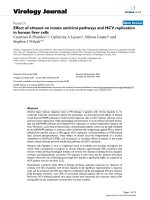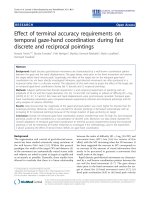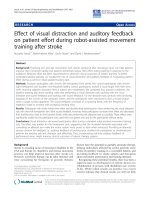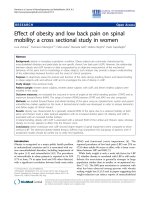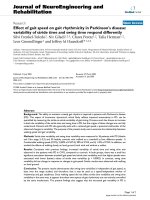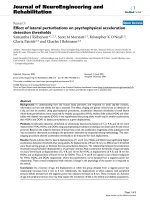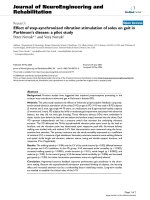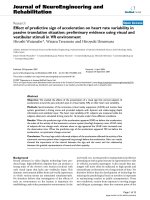Báo cáo hóa học: "Effect of montelukast on platelet activating factor- and tachykinin induced mucus secretion in the rat" doc
Bạn đang xem bản rút gọn của tài liệu. Xem và tải ngay bản đầy đủ của tài liệu tại đây (268.13 KB, 6 trang )
BioMed Central
Page 1 of 6
(page number not for citation purposes)
Journal of Occupational Medicine
and Toxicology
Open Access
Research
Effect of montelukast on platelet activating factor- and tachykinin
induced mucus secretion in the rat
Rene Schmidt
1
, Petra Staats
2
, David A Groneberg
3
and Ulrich Wagner*
4
Address:
1
Department of Anesthesiology, University Medical Center, Hugstetter Strasse 55, D-79106 Freiburg, Germany,
2
Department of Medicine,
Division of Pneumology, University Medical Center, Baldingerstrasse, D-35043 Marburg, Germany,
3
Institute of Occupational Medicine, Charité
– Universitaetsmedizin, Free University and Humboldt University, Augustenburger Platz 1, D-13353 Berlin, Germany and
4
Department of Internal
Medicine, Division of Pneumology, Klinik Loewenstein, Geißhoelzle 62, D-74245 Loewenstein, Germany
Email: Rene Schmidt - ; Petra Staats - ;
David A Groneberg - ; Ulrich Wagner* -
* Corresponding author
Abstract
Background: Platelet activating factor and tachykinins (substance P, neurokinin A, neurokinin B)
are important mediators contributing to increased airway secretion in the context of different
types of respiratory diseases including acute and chronic asthma. Leukotriene receptor antagonists
are recommended as add-on therapy for this disease. The cys-leukotriene-1 receptor antagonist
montelukast has been used in clinical asthma therapy during the last years. Besides its inhibitory
action on bronchoconstriction, only little is known about its effects on airway secretions.
Therefore, the aim of this study was to evaluate the effects of montelukast on platelet activating
factor- and tachykinin induced tracheal secretory activity.
Methods: The effects of montelukast on platelet activating factor- and tachykinin induced tracheal
secretory activity in the rat were assessed by quantification of secreted
35
SO
4
labelled mucus
macromolecules using the modified Ussing chamber technique.
Results: Platelet activating factor potently stimulated airway secretion, which was completely
inhibited by the platelet activating factor receptor antagonist WEB 2086 and montelukast. In
contrast, montelukast had no effect on tachykinin induced tracheal secretory activity.
Conclusion: Cys-leukotriene-1 receptor antagonism by montelukast reverses the secretagogue
properties of platelet activating factor to the same degree as the specific platelet activating factor
antagonist WEB 2086 but has no influence on treacheal secretion elicited by tachykinins. These
results suggest a role of montelukast in the signal transduction pathway of platelet activating factor
induced secretory activity of the airways and may further explain the beneficial properties of cys-
leukotriene-1 receptor antagonists.
Background
Increased production of airway mucus is one of the critical
pathophysiological features of bronchial asthma, cystic
fibrosis and chronic obstructive pulmonary disease
(COPD) [1]. Several mediators have been identified as key
players in mucus hypersecretion including acetylcholine,
histamine, leukotrienes, platelet activating factor (PAF),
and tachykinins [2]. The latter group belongs to a family
Published: 20 February 2008
Journal of Occupational Medicine and Toxicology 2008, 3:5 doi:10.1186/1745-6673-3-5
Received: 7 January 2008
Accepted: 20 February 2008
This article is available from: />© 2008 Schmidt et al; licensee BioMed Central Ltd.
This is an Open Access article distributed under the terms of the Creative Commons Attribution License ( />),
which permits unrestricted use, distribution, and reproduction in any medium, provided the original work is properly cited.
Journal of Occupational Medicine and Toxicology 2008, 3:5 />Page 2 of 6
(page number not for citation purposes)
of peptides (e.g. substance P, neurokinin A, neurokinin B)
which are released from airway nerves upon stimulation
[3]. We have previously demonstrated that tachykinins are
potent inducers of tracheal mucus secretion in the rat [4-
6]. Furthermore, others could prove the secretagogue
properties of PAF in rodents, swine, and human airway
tissue [7-9]. It has been postulated that PAF has the poten-
tial to generate bioactive lipids via the 5-lipoxygenase
pathway, which represents a possible mechanism mediat-
ing its secretagogue properties [10-12]. In this regard, Gos-
wami et al. could show that PAF stimulates the secretion
of respiratory glycoconjugates from human airways in cul-
ture, which was totally inhibited by the experimentally
used competitive leukotriene D
4
antagonist LY 171883
[13]. The effect of clinically available cysteinyl-leukot-
riene-1 (cys-LT
1
) antagonists (montelukast, zafirlukast, or
pranlukast) on PAF- or tachykinin induced secretory activ-
ity in the airways has never been evaluated. Therefore, it
was the aim of this study to investigate the effects of mon-
telukast on PAF- and tachykinin induced tracheal mucus
secretion.
Methods
Reagents
Pentobarbital sodium (Nembutal
®
) for anesthesia was
obtained from Sanofi (München, Germany). Sodium
azide and acetylcholine were purchased from Merck
(Darmstadt, Germany). Substance P, neurokinin A, and
neurokinin B were from Bachem (Heidelberg, Germany).
PAF was purchased from Calbiochem (Bad Soden, Ger-
many). WEB 2086 was from Boehringer Ingelheim (Biber-
ach, Germany). Na
2
35
SO
4
for radiolabelling glycoproteins
was from Amersham (Braunschweig, Germany) and mon-
telukast (MK-476) was received as a gift from Merck Frosst
(Quebeck, Canada). Substance P, neurokinin A, and neu-
rokinin B were dissolved in aqua ad injectabilia. The vehi-
cle for PAF was ethanol. Montelukast and WEB 2086 were
dissolved in dimethylsulfoxid (DMSO). Maximum con-
centrations of ethanol or DMSO during the experiments
were 0.5%. None of the vehicles showed any significant
effects on tracheal secretory activity (data not shown).
Animals
Male Sprague-Dawley rats (Harlan Winkelmann GmbH,
Borchen, Germany) with an average body weight of 436 ±
42 g were used for all experiments. The experimental pro-
tocol was approved by the local animal care and use com-
mittee, and all animals received humane care according to
the criteria outlined in the Guide for the Care and Use of
Laboratory Animals [14]. The animals were kept in a light-
and temperature controlled room and had free access to
water and a rat standard diet (Altromin, Lage, Germany).
Tissue preparation
The modified Ussing chamber technique is well estab-
lished for measurement of tracheal secretion and has been
described in detail previously [15]. Briefly, rats were anes-
thetized by an intraperitoneal injection of 70 mg*kg
-1
body weight pentobarbital sodium. The trachea was
excised through a ventral collar midline incision and
median sternotomy and immediately transferred to an
organ bath filled with medium M199 in Earle's balanced
salt solution (Gibco, Eggenstein, Germany), equilibrated
with carbogen gas (95% oxygen, 5% carbon dioxide).
After removing the connective tissue, the trachea was
opened along the paries membranaceus and mounted
between the two halves of the modified Ussing chamber.
According to the volume of the perfusion device, seven
millilitres of medium M199 were added to the luminal
(i.e. mucosal) and submucosal sides, respectively. The pH
was adjusted to 7.41 and a constant temperature of 37°C
was maintained during the whole experiment.
Radiolabelling and measurement of airway glycoprotein
secretion
50 µCi Na
2
35
SO
4
were added to the solution bathing at the
submucosal side and allowed to equilibrate with the tis-
sue for the duration of the experiment. After 2 h the
release of bound
35
SO
4
to the mucosal side reaches steady
state [15]. Subsequently the luminal solution was col-
lected every 15 minutes and replaced with fresh medium.
The perfusate samples from the luminal side were col-
lected in cellulose dialysis tubing (12,000 – 14,000 Da
molecular mass cut-off, Serva, Heidelberg, Germany) and
dialysed against distilled water containing unlabelled
Na
2
SO
4
, to remove unincorporated
35
SO
4
, and sodium
azide (10 mg*L
-1
) to prevent bacterial degradation. Dialy-
sis was complete when the radioactive count of the dialy-
sis fluid 3 h after the last change was the same as before
dialysis. The samples were transferred to plastic vials
mixed with 10 ml of szintillant (Lumagel
®
, Baker,
Deventer, Netherlands) and radioactivity was measured
using a liquid szintillation counter (Rackbeta LKB 1219,
LKB Instruments, Graefeling, Germany). The counts of
labelled macromolecules represent the secretory activity.
Former studies from our lab using high-performance liq-
uid chromatography (HPLC) and autoradiography identi-
fied these labelled macromolecules as airway secretory
glycoproteins from the submucosal glands, which were
not digested by chondroitinase ABC. Thus, these macro-
molecules are true glycoproteins.
Experimental design
After two hours of incubation, samples were collected
every 15 minutes. The average of two samples before phar-
macological intervention represented the basal secretion
rate (= 100%). Drugs were applied to the mucosal side
and collections were taken 15 minutes later. Between each
Journal of Occupational Medicine and Toxicology 2008, 3:5 />Page 3 of 6
(page number not for citation purposes)
application, at least four samples were collected to allow
the system to recover and reach a basal secretion again. In
order to test the viability of the system, each experiment
was finished with a stimulation of acetylcholine (1 µM),
an established secretagogue for this system.
Data analysis
Data are expressed in percent of basal secretion ± SEM.
Statistical analysis was performed with Student's t-test for
paired samples. Experiments with five animals per group
were performed for each experimental protocol. Data
were considered significant when P < 0.05. Statistical anal-
ysis was performed using the Sigma Stat software package
(Jandel Scientific, San Rafael, CA).
Results
Effect of WEB 2086 on PAF induced tracheal secretory
activity
The effect of the PAF receptor antagonist WEB 2086 on
PAF induced tracheal secretory activity is depicted in fig-
ure 1. PAF (100 µM) stimulates secretion significantly to
levels up to 185 ± 10% of baseline. Application of WEB
2086 (100 µM) led to a moderate suppression of baseline
secretion (85 ± 5%). Co-administration of PAF (100 µM)
and WEB 2086 (100 µM) abolished the increase of secre-
tion observed under PAF application alone (105 ± 10% of
baseline).
Effect of montelukast on PAF induced tracheal secretory
activity
Figure 2 shows the influence of the cys-LT
1
receptor antag-
onist montelukast on PAF induced tracheal secretory
activity. PAF application (100 µM) led to an increase of
mucus secretion up to 205 ± 49% of baseline levels. The
addition of montelukast (10 µM) to the culture medium
had no significant effect on the secretion levels (95 ± 6%).
Combination of PAF (100 µM) and montelukast (10 µM)
completely blocked the secretagogue effect observed
under PAF application alone (94 ± 5%).
Effect of montelukast on substance P, neurokinin A, and
neurokinin B induced tracheal secretory activity
As shown in figure 3A, substance P (1 µM) stimulated tra-
cheal secretory activity significantly. Montelukast admin-
istration (10 µM) alone exerted no effect on baseline
secretion (91 ± 3%) and had no modulating capacity on
substance P induced mucus secretion (substance P: 147 ±
14%; substance P + montelukast: 153 ± 28%). Figure 3B
depicts the effect of montelukast on neurokinin A induced
tracheal secretory activity. Neurokinin A (1 µM) increased
secretion significantly (120 ± 7%). Montelukast alone had
no effect on baseline secretion (98 ± 5%) and could not
influence the neurokinin A induced increase of tracheal
secretion (neurokinin A + montelukast: 127 ± 9%). The
effect of montelukast on neurokinin B induced tracheal
mucus secretion is presented in figure 3C. Neurokinin B
(1 µM) stimulated mucus secretion (153 ± 12%). Monte-
Effects of montelukast on platelet activating factor (PAF) induced tracheal secretory activity in the ratFigure 2
Effects of montelukast on platelet activating factor
(PAF) induced tracheal secretory activity in the rat.
Data are expressed as mean ± SEM for n = 5 animals per
group. *P < 0.05 versus respective baseline secretion values
(within each group);
#
P < 0.05 versus PAF.
0
50
100
150
200
250
300
*
Montelukast 10 µM
PAF 100 µM
PAF 100 µM
+ Montelukast 10 µM
[% of baseline]
Tracheal secretory activity
#
#
Effects of WEB 2086 on platelet activating factor (PAF) induced tracheal secretory activity in the ratFigure 1
Effects of WEB 2086 on platelet activating factor
(PAF) induced tracheal secretory activity in the rat.
Data are expressed as mean ± SEM for n = 5 animals per
group. *P < 0.05 versus respective baseline secretion values
(within each group);
#
P < 0.05 versus PAF.
PAF 100 µM
+ WEB 2086 100 µM
WEB 2086 100 µM
PAF 100 µM
[% of baseline]
0
50
100
150
200
250
300
*
#
#
*
Tracheal secretory activity
Journal of Occupational Medicine and Toxicology 2008, 3:5 />Page 4 of 6
(page number not for citation purposes)
lukast alone did not modulate the basal secretion rate and
had no influence on neurokinin B induced mucus secre-
tion when given in combination (montelukast: 98 ± 5%;
neurokinin B + montelukast: 160 ± 21%).
Discussion
The aim of the present study was to characterize the effects
of the clinically used cys-LT
1
receptor antagonist montelu-
kast on PAF- and tachykinin induced tracheal secretory
activity in the rat. Our results could demonstrate that PAF
potently stimulates tracheal mucus secretion. This could
be completely blocked by administration of the selective
PAF receptor antagonist WEB 2086 as well as montelu-
kast. In addition, we could show that the tachykinins sub-
stance P, neurokinin A, and neurokinin B also
significantly increased tracheal mucus secretion. In con-
trast to the inhibition of PAF induced secretion, montelu-
kast did not modulate tachykinin stimulated secretory
activity.
Recently, we demonstrated that the cys-LT
1
-receptor
antagonist zafirlukast is a potent stimulator of tracheal
secretion in the rat [16]. In contrast, montelukast has
much lower potency and does not exert secretagogue
effects until concentrations of 100 µM are reached. There-
fore, we used 10 µM montelukast in the present study to
evaluate the effects of this cys-LT
1
receptor antagonist on
PAF and tachykinin stimulated tracheal secretory activity
in the rat.
The naturally occurring phospholipid mediator PAF (1-O-
alkyl-2-acetyl-sn-glycero-3-phosphocholine) is produced
by a variety of inflammatory cells including neutrophils,
alveolar macrophages, mast cells, eosinophils, and others.
PAF originates from cleavage of membrane phospholipids
by phospholipase A
2
yielding lyso-PAF, which is further
acetylated to form biologically active PAF. Its degradation
to the inactive lyso-PAF is catalysed by a PAF-specific
acetylhydrolase, which is abundantly present in plasma
and intracellularly in several inflammatory cells [17]. PAF
supports the pathogenesis of many inflammatory reac-
tions, including airway inflammation. Besides bronchoc-
onstriction, microvascular leakage, recruitment and
activation of eosinophils and airway hyperresponsive-
ness, PAF is seriously involved in mucus hypersecretion
which is a critical feature of the inflammatory process and
occurs during asthma, chronic obstructive airway disease,
or pneumonia [18]. PAF has been shown to serve as a
powerful mucus secretagogue in the airways of animals
and humans [13,19]. The mechanism of PAF induced air-
way hypersecretion has been extensively studied during
the last years. It could be demonstrated that the PAF medi-
ated effect does not depend on a cholinergic mechanism
or the generation of histamine. In contrast, accumulating
evidence supports the notion that the pulmonary effects
of PAF could be mediated by the secondary release of leu-
kotrienes [18]. It is now widely accepted that a significant
amount of peptidoleukotrienes are generated in response
to a PAF challenge and that these products of the arachi-
donic acid metabolism are at least in part responsible for
Effects of montelukast on tachykinin (substance P (A), neuro-kinin A (B), neurokinin B (C)) induced tracheal mucus secre-tion in the ratFigure 3
Effects of montelukast on tachykinin (substance P
(A), neurokinin A (B), neurokinin B (C)) induced tra-
cheal mucus secretion in the rat. Data are expressed as
mean ± SEM for n = 5 animals per group. *P < 0.05 versus
respective baseline secretion values (within each group);
#
P <
0.05 versus montelukast.
0
50
100
150
200
[% of baseline]
Tracheal secretory activity
Montelukast 10 µM
Substance P 1 µM
Substance P 1 µM
+ Montelukast 10 µM
*
#
#
*
A
0
50
100
150
200
#
*
#
*
[% of baseline]
Tracheal secretory activity
Montelukast 10 µM
Neurokinin A 1 µM
Neurokinin A 1 µM
+ Montelukast 10 µM
B
0
50
100
150
200
#
*
#
*
[% of baseline]
Tracheal secretory activity
Montelukast 10 µM
Neurokinin B 1 µM
Neurokinin B 1 µM
+ Montelukast 10 µM
C
Journal of Occupational Medicine and Toxicology 2008, 3:5 />Page 5 of 6
(page number not for citation purposes)
the proposed PAF mediated effects [20,21]. In addition, it
could be shown that inhibition of the arachidonic acid
pathway by administration of dexamethasone or inhibi-
tors of the lipoxygenase or cyclooxygenase pathway com-
pletely blocked the secretagogue properties of PAF
[7,13,21]. Furthermore, the experimentally used leukot-
riene receptor antagonist LY 171883 totally inhibited
PAF-induced secretion of respiratory glycoconjugates
from human airways in culture, indicating a critical role
for leukotrienes in PAF induced hypersecretion [13]. The
results of the present study confirm these data and add
new information concerning the clinically used cys-LT
1
receptor antagonist montelukast. While the administra-
tion of montelukast alone had no effect on tracheal secre-
tory activity, it completely inhibited PAF stimulated
airway secretion in our setting. Regarding this effect, mon-
telukast was as effective as the specific PAF receptor antag-
onist WEB 2086.
In addition, we could confirm earlier studies from our
group indicating the secretagogue properties of the tachy-
kinins substance P, neurokinin A, and neurokinin B in the
same model. Nevertheless and unlike our previous results,
neurokinin B exerted more potent secretagogue effects
than neurokinin A in the present experimental series. Fur-
thermore, mucus secretion in response to stimulation
with the tachykinins was slightly lower when comparing
earlier studies from our group with the results of the
present investigation. It has been shown that the secretory
activity of the airways could be influenced by the circadian
rhythm, which could be one explanation for these differ-
ences. Moreover, the Ussing chamber position on the tra-
cheal surface critically affects the amount of secreted
mucus macromolecules and variations in that regard
could also not be excluded. Crimi and colleagues have
shown in human patients that montelukast abolishes the
bronchoconstrictor airway response to neurokinin A,
lending support to the hypothesis that tachykinins might
elicit bronchoconstriction indirectly through the release
of cys-LTs [22]. In sharp contrast to the abovementioned
action in the context of bronchoconstriction, montelukast
did not modulate neither substance P nor neurokinin A or
neurokinin B stimulated tracheal secretory activity in our
setting.
Conclusion
In conclusion, our data show that the clinically used cys-
LT
1
receptor antagonist montelukast inhibits PAF induced
tracheal secretory activity to the same degree as the spe-
cific PAF receptor antagonist WEB 2086. No modulating
effect could be demonstrated after montelukast adminis-
tration when airway secretion was stimulated by tachyki-
nins. These findings may contribute to the beneficial
effect of montelukast in the treatment of bronchial
asthma.
Competing interests
The author(s) declare that they have no competing inter-
ests.
Authors' contributions
RS, PS, DAG and UW have been involved in the design
and conduct of the study. Also they have participated in
drafting the article or revising it critically for important
intellectual content. They have all given approval of the
study to be published.
Acknowledgements
We would thank Heike Priebe for her expert technical assistance. This
study was supported by the Deutsche Forschungsgemeinschaft (Wa844/3-
2).
References
1. Danahay H, Jackson AD: Epithelial mucus-hypersecretion and
respiratory disease. Curr Drug Targets Inflamm Allergy 2005,
4:651-64.
2. Rogers DF: Physiology of airway mucus secretion and patho-
physiology of hypersecretion. Respir Care 2007, 52:1134-46. dis-
cussion 1146-9.
3. Groneberg DA, Harrison S, Dinh QT, Geppetti P, Fischer A: Tachy-
kinins in the respiratory tract. Curr Drug Targets 2006, 7:1005-10.
4. Wagner U, Fehmann H, Bredenbroker D, Kluber D, Lange A,
Wichert P: Effects of selective tachykinin-receptor antago-
nists on tachykinin-induced airway mucus secretion in the
rat. Neuropeptides 1999, 33:55-61.
5. Wagner U, Fehmann HC, Bredenbroker D, Yu F, Barth PJ, von
Wichert P: Galanin and somatostatin inhibition of neurokinin
A and B induced airway mucus secretion in the rat. Life Sci
1995, 57:283-9.
6. Wagner U, Fehmann HC, Bredenbroker D, Yu F, Barth PJ, von
Wichert P: Galanin and somatostatin inhibition of substance
P-induced airway mucus secretion in the rat. Neuropeptides
1995, 28:59-64.
7. Rieves RD, Goff J, Wu T, Larivee P, Logun C, Shelhamer JH: Airway
epithelial cell mucin release: immunologic quantitation and
response to platelet-activating factor. Am J Respir Cell Mol Biol
1992, 6:158-67.
8. Lundgren JD, Kaliner M, Logun C, Shelhamer JH: Platelet activating
factor and tracheobronchial respiratory glycoconjugate
release in feline and human explants: involvement of the
lipoxygenase pathway. Agents Actions 1990, 30:329-37.
9. Steiger J, Bray MA, Subramanian N: Platelet activating factor
(PAF) is a potent stimulator of porcine tracheal fluid secre-
tion in vitro. Eur J Pharmacol 1987, 142:367-72.
10. Shindo K, Koide K, Fukumura M: Enhancement of leukotriene B4
release in stimulated asthmatic neutrophils by platelet acti-
vating factor. Thorax 1997, 52:1024-9.
11. Bozza PT, Payne JL, Goulet JL, Weller PF: Mechanisms of platelet-
activating factor-induced lipid body formation: requisite
roles for 5-lipoxygenase and de novo protein synthesis in the
compartmentalization of neutrophil lipids. J Exp Med 1996,
183:1515-25.
12. Shindo K, Koide K, Fukumura M: Platelet-activating factor
increases leukotriene B4 release in stimulated alveolar mac-
rophages from asthmatic patients. Eur Respir J 1998,
11:1098-104.
13. Goswami SK, Ohashi M, Stathas P, Marom ZM: Platelet-activating
factor stimulates secretion of respiratory glycoconjugate
from human airways in culture. J Allergy Clin Immunol 1989,
84:726-34.
14. Science AAfLA: Guide for the Care and Use of Laboratory Animals
Bethesda, MD: National Institutes of Health; 1985.
15. Bredenbroker D, Dyarmand D, Meingast U, Fehmann HC, Staats P,
Von Wichert P, Wagner U: Effects of the nitric oxide/cGMP sys-
tem compared with the cAMP system on airway mucus
secretion in the rat. Eur J Pharmacol 2001, 411:319-25.
Publish with BioMed Central and every
scientist can read your work free of charge
"BioMed Central will be the most significant development for
disseminating the results of biomedical research in our lifetime."
Sir Paul Nurse, Cancer Research UK
Your research papers will be:
available free of charge to the entire biomedical community
peer reviewed and published immediately upon acceptance
cited in PubMed and archived on PubMed Central
yours — you keep the copyright
Submit your manuscript here:
/>BioMedcentral
Journal of Occupational Medicine and Toxicology 2008, 3:5 />Page 6 of 6
(page number not for citation purposes)
16. Schmidt R, Staats P, Groneberg DA, Wagner U: The cysteinyl-leu-
kotriene-1 receptor antagonist zafirlukast is a potent secre-
tagogue in rat and human airways. Eur J Pharmacol 2005,
527:150-6.
17. Chung KF: Platelet-activating factor in inflammation andpul-
monary disorders. Clin Sci (Lond) 1992, 83:127-38.
18. Gomez FP, Rodriguez-Roisin R: Platelet-activating factor antag-
onists: current status in asthma. BioDrugs 2000, 14:21-30.
19. Adler KB, Akley NJ, Glasgow WC: Platelet-activating factor pro-
vokes release of mucin-like glycoproteins from guinea pig
respiratory epithelial cells via a lipoxygenase-dependent
mechanism. Am J Respir Cell Mol Biol 1992, 6:550-6.
20. Wu T, Lundgren JD, Rieves RD, Doerfler ME, Logun C, Shelhamer JH:
Platelet-activating factor stimulates eicosanoid production
in cultured feline tracheal explants. Exp Lung Res 1991,
17:1079-94.
21. Adler KB, Schwarz JE, Anderson WH, Welton AF: Platelet activat-
ing factor stimulates secretion of mucin by explants of
rodent airways in organ culture. Exp Lung Res 1987, 13:25-43.
22. Crimi N, Pagano C, Palermo F, Mastruzzo C, Prosperini G, Pistorio
MP, Vancheri C: Inhibitory effect of a leukotriene receptor
antagonist (montelukast) on neurokinin A-induced bron-
choconstriction. J Allergy Clin Immunol 2003, 111:833-9.


